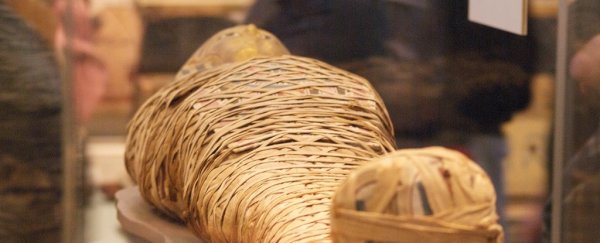Ancient Egyptians were recyclers. No, they didn't have complex facilities like we do today, but ancient priests used to take leftover papyrus from local scribes and use them to create the plaster that enshrouded mummies, sort of like how we can use newspapers to make papier-mâché masks.
For years, researchers have sought out these writings, which could contain previously unknown knowledge about the ancient civilisation, but there's one problem: getting inside the coffin without destroying its contents.
Now, that's all changing, thanks to advanced X-ray technologies and imaging techniques that are allowing archaeologists to read these long-lost documents.
Leading the charge is researcher Mike Toth, an imagining expert working at Berkeley Lab's Advanced Light Source, who has put together a team of archaeologists from Berkeley, Duke University, University College London, and Stanford University to reveal what ancient Egyptians used to write about in their everyday lives.
The cool thing about these writings is that they are the words of everyday people. Normally, the ancient texts found and studied by researchers are written by influential writers and are contained in scrolls or carved into walls so many other people can read them.
While these are always beneficial to study – who would ever pass up the chance to read a lost Homer work? – reading things written by laypeople gives researchers a unique glimpse into how normal citizens lived.
"These contain the lives and challenges of ordinary people," team member Joshua Sosin from Duke University, told Gregory Barber at Wired. "We have hate mail, the strange diary ramblings of a hypochondriac, contracts and bills of sale."
To get to these works, the team has devised a complex X-ray system using Berkeley Lab's particle accelerator, which can make electrons travel near the speed of light. These beams can flood coffins with light at increasing wavelengths, interact with the iron and other elements used in ink, and produce an extremely detailed image of the layers of papyrus.
The reason such a powerful machine has to be used for these studies is because – despite the fact that normal X-ray machines might be great at finding cavities on your teeth at the dentist office – they struggle to produce detailed images of layered papyri that have been mushed together with layers of paint for the last 2,500 years.
"For mummy cartonnage, multi-spectral radiation is a good baseline," reports Barber. "But things get complicated fast. Unlike the paper of the Gettysburg Address, the papyrus layers are haphazard, fused and interlaced with plaster into what Toth calls a 'papyrus mâché.'"
To pull it off, Stanford physicist Uwe Bergmann was brought on the team to help them use X-rays to produce signatures of different materials inside the papyrus. Basically, Bergmann has developed a way to make certain materials – say, iron used to make ink – produce a signature that the team can further analyse.
The team is currently working out all of the bugs in the system, trying to find the precise settings needed to produce the highest quality image. This involves adjusting contrast, fluorescence, and using different technologies on a need by need basis.
There's no word on when the team will have their imaging system completely figured out, but it could eventually lead to an easy way for researchers to stop destroying historical artefacts in the pursuit of knowledge.
Or, at the very least, it will be able to tell them which coffins or artefacts contain text and should be opened, because before now, it's been a messy guessing game.
H/T: Wired
